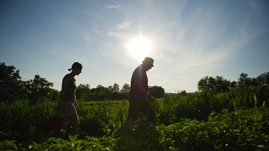Teachers' Domain - Digital Media for the Classroom and Professional Development
User: Preview

Source: Produced by the Wisconsin Educational Communications Board.
Kyle Niedfeldt Zenz, a fourth generation farmer in Bangor, WI, is the farm manager at Old Oak Family Farm. Watch as she describes the diverse crops and animals raised on the farm and the challenges they face from climate change, including pests and disease, in this multimedia video produced by the Wisconsin Educational Communications Board.
From rural landscapes to local farmers’ markets, cheesehead hats to the Wisconsin license plate, agriculture is vital to Wisconsin’s economy and culture. Research from the University of Wisconsin – Madison and UW – Extension finds that Wisconsin's farms and agricultural businesses generate nearly $60 billion in economic activity and employ 353,991 people (10% of the state’s total workforce). Wisconsin’s farms produce a diverse array of products from dairy to vegetables, raised primarily by family farms. Over half of all Wisconsin’s farms are under 100 acres, small-scale farms spanning diverse agroecological zones. An agroecological zone is shaped and defined by such factors as soil type, topography, rainfall, and climate. In recent years, changes in average yearly temperatures, rainfall, and the arrival of new pests and disease to these agroecological zones have required farmers to adapt their farming methods and practices.
Climate change research indicates that Wisconsin’s agricultural production systems will be impacted by longer frost-free periods, lower daily maximum temperatures in summer, and more summer precipitation. As a result, plant stresses may actually decrease, leading to higher yields. Interestingly, increases in carbon dioxide, one of the main causes behind global climate change, could also help increase productivity by boosting photosynthesis. However, more spring precipitation can lead to compacted, water-logged soils and thus delays in planting. Moreover, the increased precipitation may fall during more intense rain events, raising field maintenance costs and accelerating loss of soil productivity. Higher humidity and warmer winter temperatures may promote disease and fungi, which could lower yields and increase management costs. Increases in temperature, moisture, and CO2 will also encourage more vigorous weed growth. In turn, farmers may use more pesticides to combat these weeds and diseases. Ironically, a major concern is what impact these pesticides may have on native pollinators such as bees and birds, on which many crops depend.
Wisconsin farmers will need to adapt to climate change by being able to cope with uncertain conditions. One innovative strategy that has helped the small family farm adapt to fluctuations from one growing season to the next is the business model of Community Supported Agriculture (CSA). Wisconsin ranks among the top states nationwide in number of CSA farms. With a CSA, members pay in advance of the growing season to help financially support the farm. In return, the farmer delivers weekly shares of food to the members. A typical CSA farm is a small and diverse production system that is more resilient to climate change than larger, monoculture farms that rely on one or two crops. A CSA farmer can rapidly adapt the crops they grow and how they grow them to respond to changes in rainfall, warmer temperatures, and the presence of pests and disease. Moreover, members share in the risks as well as reap the benefits of the CSA, so that farms can survive crop failures resulting from unforeseen conditions. The CSA model is a great example of how we may adapt to climate change as a society: by working together to buffer the impacts of uncertainty.
Here are suggested ways to engage students with this video and with activities related to this topic.
 Loading Standards
Loading Standards